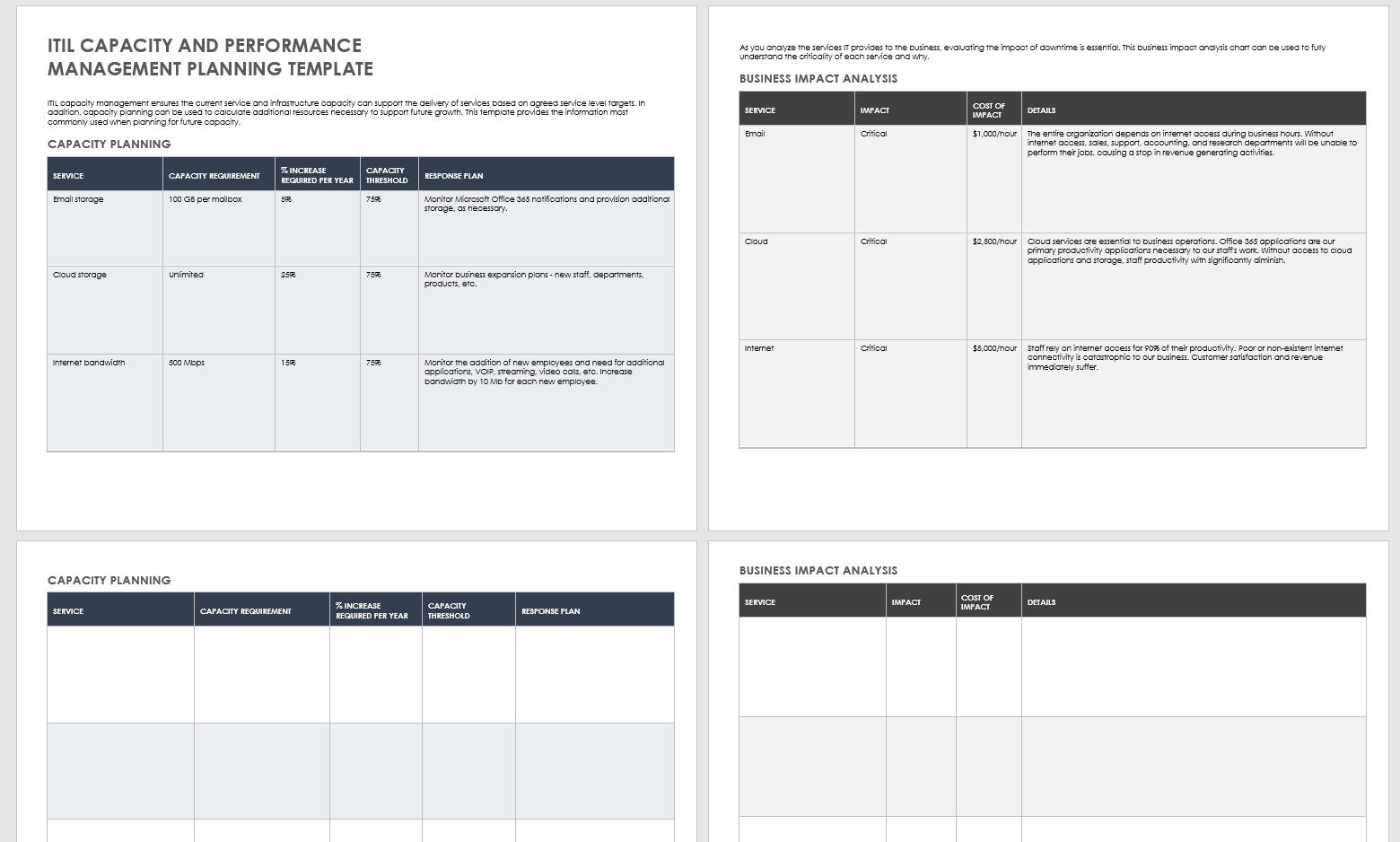What Is ITIL Capacity and Performance Management?
ITIL capacity and performance management is one of 34 ITIL management practices. This service management practice falls within the service design lifecycle stage.
What Is the Objective of ITIL Capacity and Performance Management?
The objective of ITIL capacity and performance management is to ensure that your IT capacity meets your business needs. Satisfying current and future demand in a timely and cost-effective way is key to this ITIL practice.
ITIL Capacity and Performance Management Sub-Practices
Capacity and performance management is complex. ITIL breaks the practice into three subpractices. These include business, service, and component capacity management.
- Business Capacity Management: Business capacity management is a strategic process that translates business strategy into IT service requirements. As part of IT capacity planning, business capacity management accounts for future changes to service requirements.
- Service Capacity Management: Service capacity management focuses on monitoring live IT services and gathering data to identify trends. Monitoring solutions help IT teams detect usage and performance problems in order to prevent incidents from occurring.
- Component Capacity Management: Component capacity management focuses on the performance, utilization, and capacity of individual technology components. For example, components include hard disk storage and internet throughput. Component capacity management can be reactive when an incident occurs or proactive based on trends that help predict how services impact component usage.
ITIL Capacity and Performance Management Roles and Responsibilities
People are fundamental to the ITIL framework. You must define appropriate roles to manage practices. ITIL capacity and performance management roles vary by business. Roles may include process owner, manager and practitioner, and service owner.
- Capacity Manager: The capacity manager is responsible for ensuring that you have adequate IT capacity to meet service levels, communicating with IT teams about balancing capacity and demand, and optimizing capacity. This person is responsible and accountable for the overall practice, subpractices, and results.
- Service Owner: The service owner is responsible for the service capacity management subprocess.
- Applications Analyst: The applications analyst is responsible for the component capacity management subprocess.
- Technical Analyst: The technical analyst is also responsible for the component capacity management subprocess.
ITIL V4 Capacity and Performance Management Practice Steps and Activities
The capacity and performance management team performs many tasks. These activities concern applications, hardware, and external services. Below are the team’s six major areas of responsibility, including role assignment, monitoring, analysis, and more:
- Assign Roles and Responsibilities: Use the roles outlined above to identify the appropriate team member for each role. It is not uncommon for one person to wear multiple hats.
- Research and Monitor Current Service Performance: Monitor and collect data associated with your company’s cloud services, end-user devices, networks, servers, and storage devices.
- Perform Capacity and Performance Modeling: Identify trends that help you predict future capacity requirements, and then build models based on those expected changes.
- Analyze Capacity Requirements: Evaluate your current capacity in the context of your future needs, and then calculate the impact such changes will have on your business and services.
- Forecast Demand and Plan Resources: Understand and anticipate the growth or shrinkage in demand for IT services, and then apply infrastructure resources accordingly while also reducing costs.
- Plan Performance Improvements: Develop your capacity management plan so that it satisfies your infrastructure and resource efficiency requirements.
“As a 20-year veteran in IT capacity management, I extract, summarize, and analyze performance data regularly,” shares Jonathan Gladstone, IT Systems Planner at BMO Financial Group and Professor at Georgian College in Barrie, Ontario. He adds, “I keep an eye on current performance improvement, current and future cost management, demand forecasting, and future capacity proposals. I also focus heavily on systems resource configuration to optimize our normal day-to-day capacity and failover capability.”
ITIL Capacity and Performance Management Plan Scope
The scope of the capacity management plan depends on the particular needs of your business — i.e., the resources you require to deliver timely services. Therefore, the capacity plan may contain only one IT service or all of them.
ITIL capacity management helps you ensure that the current service and infrastructure capacity can support the delivery of services based on agreed-upon service-level targets. You can also use capacity planning to calculate the additional resources you need to support future growth.
ITIL Capacity and Performance Management Planning Template
Download ITIL Capacity and Performance Management Planning Template
The ITIL capacity and performance management planning template helps you anticipate future capacity requirements. The template contains examples of both capacity planning and business impact information. It includes the data that most professionals use when planning for future capacity.
Best Practices for ITIL Capacity and Performance Management
Industry experts emphasize the importance of learning the ITIL framework as part of the overall IT initiative. See the additional best practices below.
Professor Gladstone provides two fundamental tips when it comes to ITIL capacity and performance management: “Learn ITIL, and ensure that you have data collection, monitoring, alerts, and reporting in place for the components/services/businesses you support.” Regarding the value that tools bring to the practice, he says, “There are lots of very sophisticated tools out there for these processes, but when it comes right down to it, you may be able to do the job with a competent data manipulation tool (i.e., a very good spreadsheet).”
Benefits of ITIL Capacity and Performance Management
Technological demands shift with business growth, new projects, and ad hoc work. ITIL capacity and performance management ensures that resources function regardless of the volatility of those demands. The practices below help companies remain productive amid constant change.
Larry Klosterboer is a certified IT architect who specializes in systems management at IBM’s Technology Integration Management Center in Austin, Texas. In his book, ITIL Capacity Management, he suggests, “The more processes you implement and the more tightly you integrate them, the more benefit your organization sees.”
ITIL capacity and performance management reduces potential downtime through planning: “You can start the analysis of potential benefits by reviewing your incident tickets over the past year or so. If you have a way to record capacity and performance-related tickets, focus there first. If you don’t have that capability yet, look for tickets on which the description field includes ‘slow down,’ ‘delay,’ or ‘response time,’” Klosterboer recommends. “Assume that you could have eliminated half of those tickets through better capacity planning, and you can start to project what the benefit would be to your organization.”
These benefits range from making more informed decisions to improving performance and reducing costs.
How Is Capacity Management Implemented in ITIL?
ITIL practices focus on delivering end-to-end service. You do not implement ITIL. Instead, you use it as a framework to guide your IT organization.
Whether you are following an older version of ITIL (v3) or the latest evolution (v4), you should follow the best practices above, lean into executive support, and focus on changing attitudes and behaviors. Most important, focus on customer outcomes and business value. ITIL is not a start-to-finish process; it is about continual improvement.
Maximize Your ITIL Capacity Management and Planning with Smartsheet
Empower your people to go above and beyond with a flexible platform designed to match the needs of your team — and adapt as those needs change.
The Smartsheet platform makes it easy to plan, capture, manage, and report on work from anywhere, helping your team be more effective and get more done. Report on key metrics and get real-time visibility into work as it happens with roll-up reports, dashboards, and automated workflows built to keep your team connected and informed.
When teams have clarity into the work getting done, there’s no telling how much more they can accomplish in the same amount of time. Try Smartsheet for free, today.

